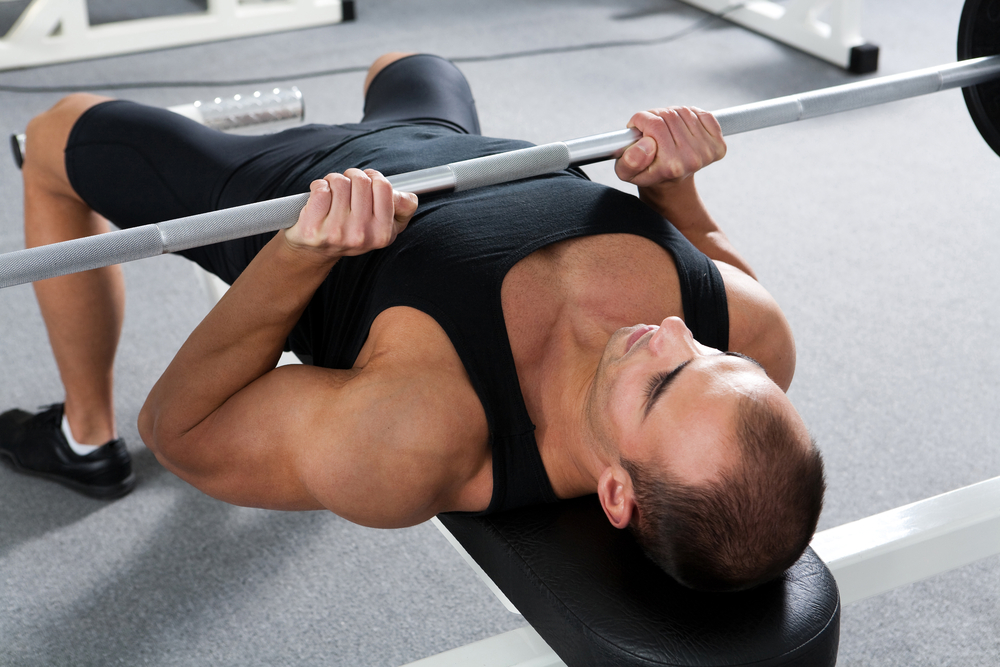The close-grip bench press is a barbell pressing variation that shifts the load away from your chest and onto your triceps by narrowing your hand placement to about shoulder-width.
To build triceps strength with this lift, focus on keeping your elbows tucked, lowering the bar with control to your lower chest, and pressing back up without locking out your elbows.
Keep reading for a step-by-step breakdown, common mistakes to avoid, and smart ways to program it into your workouts.
Proper Setup: Getting the Foundations Right
Before you even touch the bar, how you set up on the bench determines whether you’ll get the most out of the close-grip bench press—or waste effort with poor mechanics.
A stable, well-aligned setup creates the foundation for effective pressing power, minimizes unnecessary strain, and sets your triceps up to do the heavy lifting.
Step-by-Step: Dialing in Your Bench Setup
Start by lying flat on the bench, making sure your eyes are directly under the bar.
Your feet should be planted firmly on the ground—flat, not just toes—so you can create a stable base.
A slight arch in the lower back is fine (and expected), but don’t exaggerate it. Your upper back, shoulders, and glutes should remain in contact with the bench the entire time.
Next, focus on your grip. Place your hands about shoulder-width apart, or just a bit narrower, depending on your comfort and limb proportions.
This narrower grip shifts the emphasis to your triceps, but going too close can over-stress your wrists and limit your control.
A good test: your wrists should be stacked directly above your elbows when you lower the bar. If they’re inside your elbows, your grip is likely too narrow.
Once your hands are in place, lock in your upper body by pulling your shoulder blades back and down into the bench.
This creates a stable base for pressing and protects your shoulders from unnecessary strain.
At this point, your chest should be slightly elevated, your lats engaged, and your core tight.
That tension across your upper body will carry over into more stable, powerful presses.
Why Foot and Body Positioning Matters
Your lower body might not seem important in an upper-body lift, but it plays a major role in control and energy transfer.
With your feet flat and planted firmly under your knees—or slightly behind them—you generate stability and leg drive.
This drive helps keep your body anchored, so you’re not shifting or wobbling during the lift.
A common mistake is letting your feet float or shifting them during the set.
That lack of control at the base disrupts your pressing rhythm and forces your upper body to compensate.
Instead, think of your feet and glutes as part of the press—they help you stay locked in from rep to rep.
Hand Placement: Finding the Sweet Spot
Hand placement is what separates a close-grip bench press from a traditional one.
But closer doesn’t always mean better.
Going too narrow increases wrist strain and decreases bar control, which often causes your elbows to flare—exactly what you don’t want when trying to isolate the triceps.
Shoulder-width, or just inside it, is typically the best choice.
It’s close enough to emphasize the triceps, but still wide enough to allow a natural bar path and maintain wrist and shoulder alignment.
When you grip the bar, keep your wrists straight and directly stacked over your elbows—this alignment allows the bar to travel in a vertical path over your sternum with better balance and muscle engagement.
How to Perform the Close-Grip Bench Press with Perfect Form
Once your setup is locked in, the execution phase is where your technique either reinforces the triceps-focused intent—or quietly shifts tension to the wrong muscles.
Moving the bar correctly, controlling each phase, and keeping your elbows in the right position can make all the difference between meaningful strength gains and inefficient reps.
The Full Range: From Unrack to Lockout
Start by unracking the bar with control, not momentum.
Think of pressing the bar straight up from the rack until your arms are fully extended and the bar is directly over your sternum.
Don’t rush—make sure the bar is steady and centered before you begin the descent.
As you lower the bar, keep your elbows tucked in at roughly a 45-degree angle relative to your torso.
This positioning minimizes shoulder strain and maintains tension on your triceps, which is the main point of the close-grip variation.
Flaring the elbows out shifts the load to the chest and shoulders, undermining your goal.
The bar should move in a slightly angled path—downward and slightly forward—so it lands on the lower chest, not the upper chest or neck area.
If the bar touches too high, your elbows will naturally flare out, pulling emphasis off the triceps and into the delts.
At the bottom of the rep, don’t bounce the bar off your chest. Pause briefly and keep your muscles engaged.
This short pause improves control, increases time under tension, and reinforces proper technique.
To press the bar back up, drive through the same path you lowered it—slightly back and up—until your arms are fully extended.
Avoid snapping into a locked-out elbow position. Instead, aim for a strong, stable top position with the triceps fully engaged but the joints not hyperextended.
Managing Elbows and Bar Path for Triceps Emphasis
Elbow positioning is one of the biggest technical differences between a successful close-grip press and a compromised one.
Keep them close to your sides, moving in line with the bar.
When elbows stay under or slightly in front of the bar, your triceps bear the brunt of the load, which is exactly what you want.
The bar path should feel natural and fluid—not forced.
If it starts drifting too far forward or backward, it usually means something else is off: your hand width, elbow angle, or shoulder positioning.
Make small adjustments during your warm-up sets until the movement feels smooth and locked-in.
Breathing: Power and Stability in Every Rep
Breathing is often overlooked, but it plays a key role in strength and control.
As you lower the bar, take a steady breath in.
This fills your diaphragm and braces your core, giving your torso more stability throughout the lift.
Exhale as you press the bar upward.
Doing this at the point of exertion helps maintain core tension while providing enough oxygen to stay sharp and focused.
Avoid holding your breath the entire rep unless you're doing a heavy single and using a specific bracing strategy (like the Valsalva maneuver), which isn’t recommended for most lifters.
Muscles Worked: What’s Really Getting Trained

The close-grip bench press might look like a slight variation of the traditional bench press, but under the hood, it recruits your muscles in a different way—especially when it comes to the triceps.
Understanding which muscles are doing the work can help you fine-tune your technique and better integrate the lift into your overall strength plan.
The primary target here is the triceps brachii, with special emphasis on the lateral and medial heads.
While all three heads of the triceps are activated, the close grip creates a mechanical environment where the lateral and medial heads do most of the pushing.
This is due to the tucked elbow position and vertical pressing path, both of which place those two heads in the most advantageous position to generate force.
Over time, this translates into thicker, stronger triceps and a more powerful lockout in pressing movements.
But the triceps don’t work in isolation.
The pectoralis major, especially the sternal (lower) portion, contributes to the upward phase of the press.
However, because the grip is narrower than in a conventional bench press, the chest isn't the star player—it supports, rather than dominates.
This makes the close-grip bench press particularly useful for lifters who want to increase arm strength without overloading the pecs or risking shoulder strain.
You’ll also feel the anterior deltoids (the front portion of the shoulders) kick in, particularly as the bar moves off the chest and begins its upward climb.
That said, if your delts are doing too much of the work, it’s often a sign that your elbows are flaring or the bar is drifting too far forward—both common form issues that can be corrected by revisiting your setup and bar path.
One of the biggest benefits of the CGBP is its ability to build pressing strength without overloading the shoulder joint.
The close grip reduces the external rotation demand placed on your shoulders, which not only makes it a more joint-friendly variation but also helps reinforce a stronger, safer pressing pattern for other lifts like overhead press or dips.
Avoid These Common Mistakes That Sabotage Triceps Gains
You can have the best intentions and a solid program, but if your form is off, your triceps won’t get the full benefit—and worse, you might end up with joint pain instead of strength gains.
Many lifters unknowingly fall into bad habits that either reduce the effectiveness of the close-grip bench press or increase their risk of injury. Here's how to avoid those traps.
One of the most common issues is letting your elbows flare out during the press.
This shifts the emphasis away from your triceps and into your chest and shoulders, reducing the very benefits you’re aiming for.
Flaring also increases the rotational strain on your shoulders, making the movement less stable and more injury-prone.
Keeping your elbows tucked at around a 45-degree angle helps isolate the triceps and keeps the bar path efficient.
Excessive arching in the lower back is another mistake that often gets overlooked.
While a slight natural arch is helpful for stability, pushing your lower back too far off the bench—usually in an attempt to lift heavier—places stress on the spine and shifts your body out of alignment.
A better approach is to maintain a strong, engaged core and focus on full-body tension without exaggerating your posture.
Then there’s grip width, which is easy to get wrong.
A grip that’s too narrow puts unnecessary strain on your wrists and can actually reduce your ability to press smoothly.
On the other hand, going too wide moves the emphasis away from your triceps and starts to resemble a traditional bench press.
The sweet spot is typically shoulder-width or slightly narrower, allowing your wrists to stay stacked over your elbows throughout the lift.
If you feel pain or instability in your wrists, your grip may be the first place to check.
A subtle but damaging habit is bouncing the bar off your chest to gain momentum.
It might let you move more weight temporarily, but it robs your muscles of time under tension, limits your control, and raises the risk of bruising or even rib injury.
Instead, aim for a controlled descent, a brief pause at the bottom, and a smooth press back to the top.
That control is where the real strength is built.
Programming Close-Grip Bench Press for Your Fitness Level
The way you program the close-grip bench press matters just as much as how well you perform it.
Matching the intensity, volume, and frequency to your experience level is key to getting results—whether you’re building a base of strength or pushing for heavier loads.
Knowing when to progress, how much to rest, and where to position this lift in your weekly split makes all the difference.
For beginners, the priority should be mastering the movement pattern with manageable weight and consistent form.
Three sets of 8 to 10 reps is a solid starting point.
This rep range is high enough to build familiarity and muscle endurance, but low enough to avoid excessive fatigue that might lead to sloppy technique.
Resting 60 to 90 seconds between sets gives you enough time to recover without losing the groove of the movement. Don’t rush to add weight.
Instead, focus on consistent execution, feeling the triceps working throughout each rep, and gradually increasing load only once your form holds up across all sets.
More experienced lifters, on the other hand, can shift the focus toward strength.
In this case, 4 to 5 sets of 4 to 6 reps works well.
The lower rep range allows you to lift heavier while keeping control and precision.
Rest periods can be extended to 2 minutes or slightly more if needed to maintain high output across sets.
Progression here isn’t just about going heavier every week.
You can also increase total volume across the training cycle by adding another set, adjusting tempo, or combining the lift with focused triceps accessory work.
As for when to increase weight, use the rule of repeatable performance.
If you can complete all your sets with clean form and no breakdown in elbow positioning or bar speed, it’s time to nudge the weight up slightly—5 to 10 pounds at most.
If your goal is hypertrophy, you might instead keep the weight the same but add a rep or two each week until you hit the upper end of your target range, then reset slightly heavier.
In terms of weekly placement, the close-grip bench press fits best in push-focused or upper-body days.
It works well as a secondary compound movement following a primary press—like overhead press or flat bench—especially if you're trying to build triceps strength without overloading your shoulders again.
Alternatively, it can be used as a primary lift if your focus is triceps development or lockout strength in other pressing movements.
Pairing it with isolation exercises like skull crushers, rope pushdowns, or even dips helps round out the session and reinforce the movement pattern.
To get the most from this lift, align your training structure with your goals and experience.
That means knowing when to push harder, when to refine technique, and how to fit the CGBP into a bigger, well-balanced program.
Done right, it’s more than just a triceps exercise—it becomes a foundation for stronger, smarter pressing overall.
Smart Variations and Alternatives to Keep Progress Moving
Even with solid progress on the standard close-grip bench press, variety can help you overcome plateaus, address weak points, or adapt to training constraints like equipment access or joint sensitivity.
Swapping in thoughtful variations gives your triceps a fresh stimulus and keeps your routine from going stale—all while reinforcing the same pressing mechanics.
The incline close-grip bench press shifts more of the workload toward your upper chest and front delts, while still challenging the triceps.
This variation is particularly useful if you’re looking to improve pressing strength across multiple angles or if you notice your upper pressing strength lagging behind your flat bench numbers.
The incline also slightly reduces shoulder stress compared to flat pressing, depending on the bench angle.
A moderate incline (around 30 degrees) tends to strike the best balance between triceps involvement and joint comfort.
Switching to dumbbells—using a close-grip dumbbell press—can be a smart way to increase the range of motion and give your wrists a bit more freedom.
With a neutral or semi-neutral grip, dumbbells allow for small adjustments in arm path that aren't possible with a barbell, which can be a relief for those dealing with shoulder or wrist discomfort.
This version also forces both arms to work independently, helping to identify and fix any strength imbalances.
If joint pain or limited equipment is a concern, the close-grip floor press offers a shoulder-friendly alternative.
By limiting the range of motion, it takes pressure off the shoulder joint while emphasizing the top half of the press—exactly where your triceps are most involved.
It’s also an excellent tool for improving lockout strength, especially for lifters who struggle in the final third of the movement.
For those training at home or without access to weights, close-grip push-ups are a surprisingly effective bodyweight option.
With your hands placed directly under your shoulders or slightly narrower, this variation shifts the workload onto your triceps.
Keeping your elbows close to your sides is crucial for maintaining proper form and maximizing the triceps focus.
If standard push-ups become too easy, you can elevate your feet, add a weighted vest, or use tempo variations to increase difficulty.
Each of these options supports continued progress while still targeting the same muscle groups and movement patterns.
Whether you're managing joint stress, working around equipment limitations, or just looking to keep your training fresh, these variations give you the flexibility to adapt without losing sight of your strength goals.
Conclusion
The close-grip bench press is a powerful tool for building triceps strength when executed with proper form and programming.
By focusing on setup, technique, and smart progression, you’ll get better results while avoiding common pitfalls.
Use variations strategically to keep your training effective and adaptable over time.







